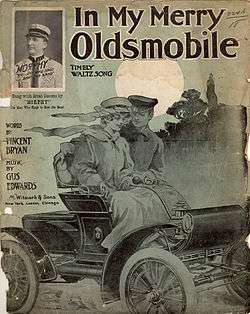Oldsmobile Curved Dash
| Oldsmobile Runabout | |
|---|---|
 | |
| Overview | |
| Manufacturer | Oldsmobile |
| Also called | Model 6 |
| Production |
1901–1907 About 19,000 built |
| Assembly | Detroit, MI[1] |
| Body and chassis | |
| Class | Entry-level car |
| Body style | Runabout |
| Powertrain | |
| Engine | 95 cu in (1,560 cc) horizontal one-cylinder[2] |
| Transmission | Planetary 2-speed |
| Chronology | |
| Successor | Oldsmobile Model 20 |

The gasoline-powered Curved Dash Oldsmobile[3] is credited as being the first mass-produced automobile, meaning that it was built on an assembly line using interchangeable parts. It was introduced by the Oldsmobile company in 1901 and produced through 1907; 425 were produced the first year,[4] 2,500 in 1902, and over 19,000 were built in all.[5] When General Motors assumed operations from Ransom E. Olds on November 12, 1908,[6] GM introduced the Oldsmobile Model 20, which was the 1908 Buick Model 10 with a stretched wheelbase and minor exterior changes.[7]
It was a runabout model, could seat two passengers, and sold for US$650. While competitive, due to high volume, and priced below the US$850 two-seat Ford Model C "Doctor's Car",[8] it was more expensive than the Western 1905 Gale Model A roadster at US$500. The Black sold for $375,[9] and the Success for US$250.[10]
The flat-mounted, water-cooled, single-cylinder engine, situated at the center of the car, produced 5 hp (3.7 kW),[2] relying on a brass gravity feed carburetor. The transmission was a semiautomatic design with two forward speeds and one reverse. The low-speed forward and reverse gear system is a planetary type (epicyclic). The car weighed 850 lb (390 kg) and used Concord springs. It had a top speed of 20 mph (32 km/h).[11]
The car's success was partially by accident—in 1901, a fire destroyed a number of other models before they were approved for production, leaving the Curved Dash the only one intact.[12]
Gallery
 1903 Model R Runabout
1903 Model R Runabout 1904 Model 6C Runabout
1904 Model 6C Runabout 1904 Model 6C Runabout with top up
1904 Model 6C Runabout with top up 1905 Model B Runabout
1905 Model B Runabout 1903 advertisement
1903 advertisement
Notes
- ↑ Location of Curved Dash factory
- 1 2 Rogliatti 1973, pp. 270–271.
- ↑ The name comes from its curved dash or dashboard, like that of a sleigh. See the photo and caption on page 130 of the Popular Science article listed under External Links below.
- ↑ Posthumus 1977, p. 48.
- ↑ Georgano 1985, p.
- ↑ Oldsmobile Joins GM
- ↑ 1908 Oldsmobile Model 20 introduction
- ↑ Clymer 1950, p. 37.
- ↑ Clymer 1950, p. 61.
- ↑ Clymer 1950, p. 32.
- ↑ Sedgwick 1962, p. 36.
- ↑ Wright 2000.
References
- Clymer, Floyd (1950). Treasury of Early American Automobiles, 1877-1925. New York, NY US: Bonanza Books.
- Frank Leslie's Popular Monthly (January, 1904)
- Georgano, G. N. (1985). Cars: Early and Vintage, 1886-1930. London, UK: Grange-Universal.
- Posthumus, Cyril (1977) [1977]. "The Motoring Boom". The story of Veteran & Vintage Cars. John Wood, illustrator (Phoebus 1977 ed.). London: Hamlyn / Phoebus. pp. 36–49. ISBN 0-600-39155-8.
The 1901 output was 425 cars, and this figure rose to 2100 in 1902, 3750 in 1903, and 5000 in 1904.
- Rogliatti, Gianni (1973). Posthumus, Cyril, ed. Period Cars. Feltham, Middlesex, UK: Hamlyn. ISBN 0-600-33401-5.
- Sedgwick, Michael (1962). Early Cars. Putnam.
- Wright, Richard A. (2000-03-08). "detnews.com | Michigan History". Apps.detnews.com. Archived from the original on 2013-03-28. Retrieved 2009-06-27.
External links
| Wikimedia Commons has media related to Oldsmobile Curved Dash. |
- Oldsmobile Club of America
- 1905 Oldsmobile Image (Suffolk County(NY) Historical Society Museum)
- Soule, Gardner (December 1951). Torrey, Volta, ed. "From Coast To Coast In An Old Old Olds". Popular Science. New York, NY US: Popular Science Publishing. 159 (6): 129–132, 258. – large 1951 article on a 1904 Olds making a coast to coast trip with detailed photo of subject
